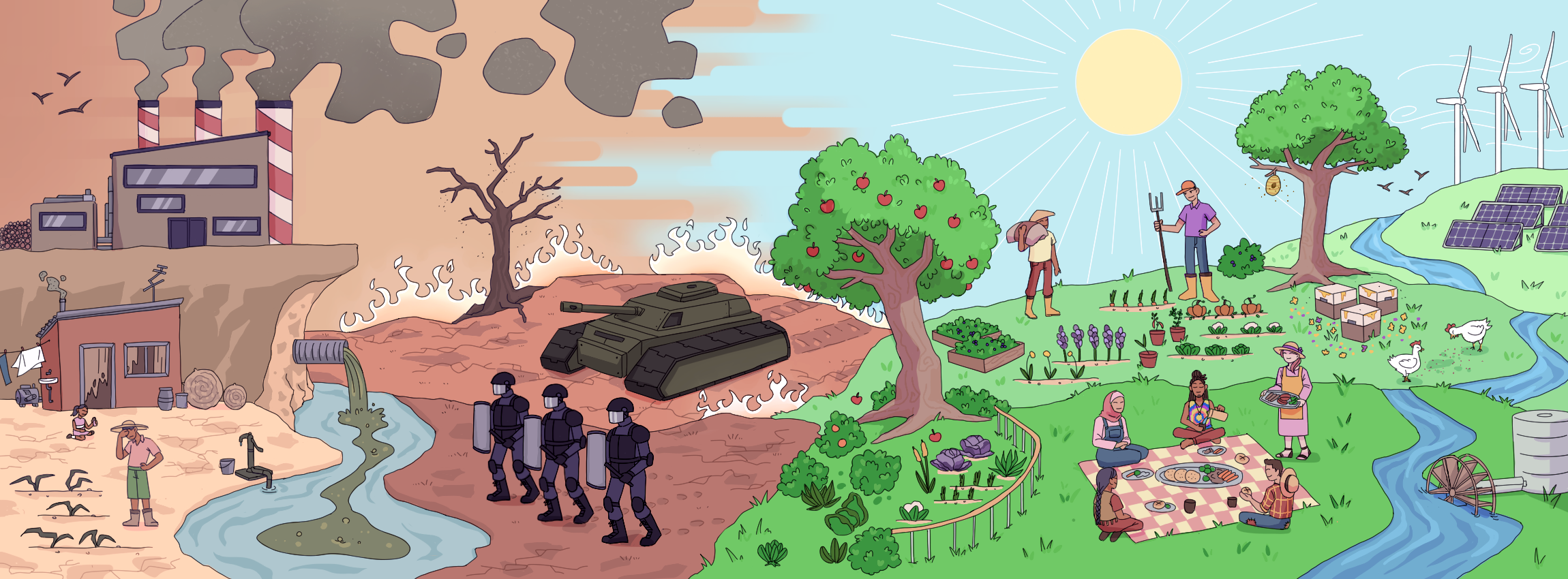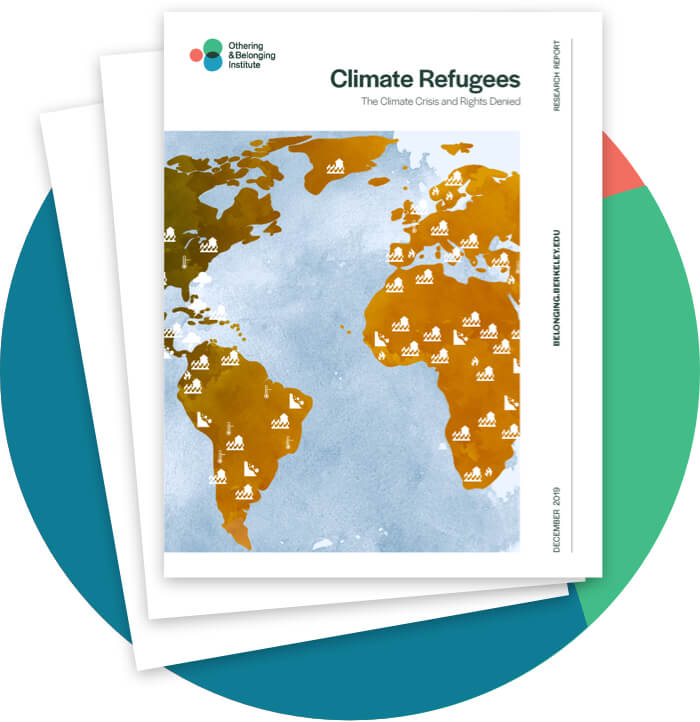Algeria
Introduction to Algeria
Algeria is a country in North Africa, bordering the Mediterranean Sea. Its population of 44.2 million1 is about 26% rural.2 Algeria has two distinct climate zones: a mediterranean Northern Algeria due to its proximity to the Mediterranean Sea and a desert climate in the rest of the country, due to the Sahara Desert.3 The Sirocco winds cause an increase in temperature, creating dust storms and dry conditions.3 Algeria is vulnerable to floods, drought, heatwaves, and wildfires, which risk intensification under the climate crisis. Most of the country is ethnically Arab but there are sizable minorities of indigenous Amazigh peoples (one-fifths of the population) and European French, Italian, and Maltese that migrated to Algeria during French colonial rule.4 Algeria has a large oil and gas industry, accounting for 19% of Algerian GDP and 93% of exports between 2016 and 2021.5 After a violent, deeply damaging war for independence from 1954-1962, Algeria still grapples with a brutal colonial history, political instability, and continued exploitative practices by the Global North, which perpetuate the country’s reliance on extractive industries and which affect climate action.6
Mapping Major Climate Events and Climate-Induced Displacement
Algeria is ranked 13th out of 179 countries, making it the 166th most climate vulnerable country in the world.7 Algeria is ranked 18 out of 184 for drought risk and about 10% of its population is exposed to the effects of drought.8 As of 2020, Algeria was projected to see a rainfall reduction of 5-13% and a temperature increase of 0.6-1.1ºC.9 Even though Algeria is already an arid country due to the Sahara Desert, this dramatic increase in drought effects will lead to a worsening of desertification, soil salinization, and pollution of surface water and therefore progressive degradation of water resources, something which is exacerbated by population growth and urbanization.10 Furthermore, the Sirocco winds work with the increasingly dry climate to create an increased susceptibility to wildfires in the Mediterranean basin, furthering drought as well.11 As recently as April 2023, Algeria experienced a record-breaking heat wave where temperatures exceeded 40ºC.12 A study found that, every year, heatwaves lead to approximately 262 deaths in Algeria.13 In 2021, 6,600 people were displaced due to a wildfire and flooding. Over the past 10 years, climate-related impacts have displaced 5,000 to 10,000 people per year.14 Critically, as revealed in a study on the Bourdj Bou Arreridj region (a rural province in central Algeria), rural women face high levels of poverty and a lack of access to education, health, and employment opportunities, especially amongst widows, divorcees, and those who head households.15 Thus, rural women are disproportionately affected by such climate impacts due to preexisting economic inequalities.
Mapping the Costs of the Climate Crisis
Algeria has a GDP of $163.04 million.16 Over the past 60 years, floods have accounted for 60% of climate events and affected more than 800,000 Algerians, creating economic costs exceeding $1.5 billion.17 Climate change already costs Algeria 1.8% of its GDP annually.18 Additionally, Algeria will face economic and non-economic costs alike due to the climate crisis. For example, predicted decreases in rainfall and predicted population growth may threaten access to water for millions of Algerians.19 Algeria’s agricultural industry is expected to suffer, as the country loses 400,000 hectares of land annually due to erosion, drought, and desertification is expected to reduce grain yields by 50%.20 The 17 million hectares of High-Plain Steppes in particular are at great risk of further desertification, creating lower employment in the agricultural sector and less food security for poorer Algerians. Hotter and drier climates, caused by climate change, along with diminishing access to freshwater increase the risk of a cholera outbreak,21 something Algeria already dealt with in 2018.22 These effects will only worsen as the climate crisis increases in intensity.
Mapping Resilience and Mitigation Pathways
Algeria’s NDC centers around institutional strengthening, adaptation to climate change, mitigation of emissions of GHG and human capacity building.23 Their unconditional goal is to reduce emissions by 7% in 2030 and their conditional goal is to reduce emissions by 22%, dependent on finance, technology development and transfers, and capacity building. Sectors targeted for mitigation and adaptation include energy, industry, transport, waste, water resources, agriculture, and forests.24 In response to land impoverishment and drought, Algeria has launched government-funded projects like the construction of a “great green dam” (a forest cover that spans 2.4 million hectares) as a carbon sink and the rehabilitation of pastoral lands through forage planting (planting specifically for livestock grazing during dry periods).25 These programs have been quite successful in countering the effects of desertification and agricultural shortage. Additionally, Algeria has used an energy mix based mostly on natural gas, which is more climate-friendly than coal. They have built operational combined-cycle power plants, which blend solar energy and natural gas, and have taken efforts to reduce gas flaring emissions.26 With regards to climate refugees, Algeria has tended toward a strict, security-based stance on migration.27 In 2022, 12,826 political refugees resided in urban areas in Algeria and at least 21,870 persons were expelled to Niger at the beginning of the year.28 As the country faces influxes of political refugees and climate-displaced people from Tunisia, Libya, Egypt, and Syria, there is a major need for better resources and programs that support such asylum-seekers.
Necessary Changes
Algeria has already demonstrated a strong commitment to international climate cooperation, through their adherence to the Kyoto Protocol in 2005 and their participation in the Paris Agreement.26 Additionally, strong government programs (like the “great green dam” and pastoral rehabilitation) as well as demonstrated financial commitment to renewable energy prove that there is a political will and resources for climate action in Algeria. In 2019, the Algerian government authorized a new law governing hydrocarbon activity and allowing the exploitation of shale gas, something which is contradictory to their existing progress on climate action.29 Beyond the reversal of such policies, more needs to be done given how drastic the effects of drought and desertification is on the rural agricultural population and Algeria must strengthen sustainable land use practices and increase land resilience. Furthermore, since many North African countries face the same climate events, greater regional cooperation with regards to sharing information and practices will help with mitigation and adaptation.30 Alongside his work towards institutional reforms in taxation and economic inequality, the current president, Abdelmadjid Tebboune, has shown a commitment to such climate action31 by proposing an African Fund for climate change disasters at COP27.32 Internally, the Algerian government must also recognize the Amazigh population as an indigenous group and pay attention to how climate events disproportionately impact them, as they reside in mountainous and arid zones that are the first to feel climate impacts.29 Due to a lack of legitimization, little data is available about the Amazigh response to the climate crisis but indigenous communities have useful strategies and practices that will benefit Algerian climate action. Internationally-backed adaptation and mitigation efforts should support the work already being done on the ground to ensure that affected workers’ voices are amplified in the process of just transition, and also help bolster the participation of directly impacted local communities in decision-making. Through this collaborative approach of capacity building for climate action, Algerian climate progress can also be sustained and expanded.
Citations
- 1“Population, total – Algeria,” The World Bank, Jun 6, 2023, https://data.worldbank.org/indicator/SP.POP.TOTL?end=2017&locations=DZ&….
- 2“Rural Population – Algeria,” The World Bank, Jun 6, 2023, https://data.worldbank.org/indicator/SP.RUR.TOTL?locations=DZ&most_rece….
- 3 a b “Algeria – Climatology,” Climate Change Knowledge Portal, Jun 6, 2023, https://climateknowledgeportal.worldbank.org/country/algeria/climate-da….
- 4“Algeria – People,” Britannica, June 6, 2023, https://www.britannica.com/place/Algeria/Drainage#ref46510.
- 5“The World Bank in Algeria, The World Bank, Jun 6, 2023, https://www.worldbank.org/en/country/algeria/overview.
- 6“Algeria – Colonial Rule,” Britannica, Jun 6, 2023, https://www.britannica.com/place/Algeria/Colonial-rule.
- 7“Vulnerability, adjusted for GDP,” ND-GAIN Country Index, Jun 6, 2023, https://gain-new.crc.nd.edu/ranking/delta/vulnerability.
- 8“Algeria – Vulnerability,” Climate Change Knowledge Portal, Jun 6, 2023, https://climateknowledgeportal.worldbank.org/country/algeria/vulnerabil….
- 9Touitou Mohammed, Abul Quasem Al-Amin, “Climate change and water resources in Algeria: vulnerability, impact and adaptation strategy” [EES], Economic and Environmental Studies, 414, Jun 6, 2023, https://bibliotekanauki.pl/articles/435066.pdf.
- 10[EES] 414
- 11Chiraz Belhadj-Khedher, Taoufik El-Melki, Florent Mouillot 3, “Saharan Hot and Dry Sirocco Winds Drive Extreme Fire Events in Mediterranean Tunisia (North Africa),” MDPI, Jun 6, 2023, https://www.mdpi.com/2073-4433/11/6/590.
- 12Morgan Winsor, “Recent heat wave in the Mediterranean caused by climate change: Study,” ABC News, Jun 6, 2023, https://abcnews.go.com/International/researchers-extreme-heat-mediterra….
- 13Sam Ezra Fraser-Baxter, “Study finds recent heatwave in Africa and Europe was fuelled by climate change,” Imperial College London, Jun 6, 2023, https://www.imperial.ac.uk/news/244753/study-finds-recent-heatwave-afri….
- 14“Algeria,” Internal Displacement Monitoring Centre, Jun 6, 2023, https://www.internal-displacement.org/countries/algeria.
- 15“Rural Algerian women take charge of their own lives, empower others,” UN Women, Jun 6, 2023, https://www.unwomen.org/en/news/stories/2018/3/feature-rural-algerian-w….
- 16“GDP (current US$) – Algeria,” The World Bank, Jun 6, 2023, https://data.worldbank.org/indicator/NY.GDP.MKTP.CD?end=2021&locations=….
- 17Leila Bensmaine “Climate Change in Algeria and its Impacts,” Assafir Al-Arabi, Jun 6 2023,
https://assafirarabi.com/en/48562/2022/11/05/climate-change-in-algeria-…. - 18Andrew Farrand, “Against the flow: Europe’s role in kickstarting Algeria’s green transition,” European Council on Foreign Relations, Jun 6, 2023,
https://ecfr.eu/publication/against-the-flow-europes-role-in-kickstarti…. - 19“North Africa: The Impact of Climate Change to 2030: Geopolitical Implications,” National Intelligence Council, Jun 6, 2023, https://www.dni.gov/files/documents/2009%20Conference%20Report_North%20….
- 20Bensmaine, Assafir Al-Arabi.
- 21Gina E. C. Charnley, et al, Exploring relationships between drought and epidemic cholera in Africa using generalised linear models (BMC Infectious Diseases, 2021), Jun 6, 2023, https://bmcinfectdis.biomedcentral.com/articles/10.1186/s12879-021-0685….
- 22“2018 - Algeria,” World Health Organization, Jun 6, 2023, https://www.who.int/emergencies/disease-outbreak-news/item/14-september…
- 23Intended Nationally Determined Contribution INDC-Algeria [NDC] (The People’s Democratic Republic of Algeria, 2015), Jun 6, 2023, https://unfccc.int/sites/default/files/NDC/2022-06/Algeria%20-%20INDC%2….
- 24“NDA Strengthening and Country Programming support for Algeria through National Agency on Climate Change” [Green Climate Fund], Green Climate Fund, Jun 6, 2023, https://www.greenclimate.fund/document/nda-strengthening-and-country-pr….
- 25[NDC] 4-5
- 26 a b [Green Climate Fund]
- 27Mohamed Saïb Musette, “Aspects of crisis migration in Algeria,” Forced Migration Review, Jun 6, 2023, https://www.fmreview.org/crisis/musette.
- 28“Algeria Strategy 2023: Situation Analysis,” UNHCR, Jun 6, 2023, https://reporting.unhcr.org/operational/operations/algeria.
- 29 a b “Indigenous World 2020: Algeria,” IWGIA, Jun 6, 2023, https://www.iwgia.org/en/algeria/3574-indigenous-world-2020-algeria.html.
- 30Janpeter Schilling, et al, Climate change vulnerability, water resources and social implications in North Africa (Regional Environmental Change, 2020), Jun 6, 2023,
https://link.springer.com/article/10.1007/s10113-020-01597-7#Sec12. - 31Zine Labidine Ghebouli, “The post-Hirak presidency: Tebboune’s promises and achievements two years on,” Middle East Institute, Jun 6, 2023, https://www.mei.edu/publications/post-hirak-presidency-tebbounes-promis….
- 32“President Tebboune proposes African Fund for climate change disasters,” People’s Democratic Republic of Algeria: Embassy of Algeria to the United States, Jun 6, 2023, https://algerianembassy.org/president-activities/president-tebboune-pro….


